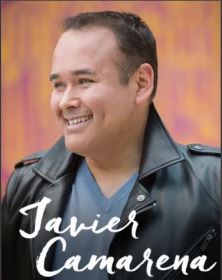CAMARENA HAS BELLAS ARTES IN HIS SOUL
When I was 19, I friend asked if I’d like to drive to San Francisco from L.A. to hear Luciano Pavarotti in recital. Being a musical theater buff, it took quite a bit of convincing to get me into anything that smacked of opera, especially 400 miles away. I don’t have to tell you what happened on that night — I never heard anything like it before or since. I think every time I attend an opera now, I’m waiting for anyone who even comes close to the Italian maestro. Clearly, it hadn’t happened. Until last night.
Now, let me come clean first. There are more magnificent tenors out there than I can name. And last month at San Francisco Opera, I was lucky to see Pene Pati, who not long before opening night replaced Bryan Hymel as Romeo in Gounod’s Roméo et Juliette (review here). Mr. Pati quite simply blew me away. As the impetuous, teenaged Romeo, his barrel chest and full-throated tenor was backed by the lighter, more sentimental style of Gounod. When he laid out one high-C, I do believe it is both the longest and strongest I’ve heard in years and years. And his “L’amour’¦ Ah! leve-toi, soleil” below Juliet’s window was breathtakingly beautiful.
Which brings us to Mexican tenor Javier Camarena, who appeared last night in L.A. in recital with Cuban-born pianist Ãngel RodrÃguez. Now we all know this Veracruz native is one of the most heralded tenors of our time. His latest CD, Contrabandista is a stunning collection of arias with a salute to Spanish tenor Manuel GarcÃa; it perfectly captures Camarena’s trademark ornate bel canto and the fresh clear-toned quality of his powerhouse High C. He has had encores of individual arias at The Met three times; one from earlier this year of “Ah! mes amis” from Donizetti’s La Fille du Régiment — which has a sequence of nine High C’s — has already received legendary status. And when I saw him in LA Opera’s lackluster The Pearl Fishers (Les Pêcheurs de Perles), he overcame being miscast with exquisite control, his voice delicate yet intractable.
When he opened his recital at the Chandler, courtesy of LA Opera, he announced what no one wants to hear, especially I’m sure the couple next to me — they flew in from Santa Fe for this shindig: In essence, Camarena said that he had been suffering from “allergies and stuff…” Now, what was that about? While I admit his voice was a bit thin in the first two of thirteen arias (including encores) — “Nel furor delle tempeste” (Bellini’s Il Pirata); “Una furtiva lagrima” (Donizetti’s L’Elisir d’Amore) — his warmth and amorousness still filled the giant auditorium, which was well-filled with well-wishers. There was fortunately no problem with later pieces. In fact, I can easily say that it was the most mind-boggling recital since Signor Pavarotti. Camerana is indeed glorious. He doesn’t have the otherworldly power that separated Pavarotti from, well, anyone else. But he could one day.
His inspiring recital was as much an appreciation as it was a showcase. Rabid fans couldn’t get enough of his charm, charisma, boyishness, and — yes — those High C’s. (He got enormous applause from the expectant house just for announcing the “allergies,” after which Camarena said, “Fortunately, I chose a very easy program.”) The first act ended with two of the arias that he encored at The Met: First was “Si, ritrovarla io giuro” from Rossini’s La Cenerentola. With extraordinary tone and unimpeachable diction, not to mention exciting top notes and that seemingly effortless High D, patrons gave what must be now a de rigeur standing ovation. To say that he is well-loved is an understatement. (He truly had me in the palm of his hand when he went backstage for a brief rest in between arias and had to knock on the door leading offstage to exit with a shoulder-shrugging wry smile and “What if they don’t let me out of here?”; that kind of sense of humor always wins me over.) “The next one is new for me,” he said after returning for the aforementioned “Ah! mes amis.” Free of pretense, off he went with those nine rich, strong, striking High Cs (but no encore here — those would come later).
 The Latin-themed second act — popular zarzuela arias and songs by Spanish and Latin American composers — confirmed why opera has so many devoted fans. One of the most beautiful instruments known to mankind is the human voice, and with splendid variety Camarena showed why this is so: He was simple and dulcet in “Flor roja” from Jacinto Guerrero’s Spanish opera, Los Gavilanes, and romantic and bittersweet while banging out high notes in “No puede ser” from Pablo Sorozábal’s La Tabernera del Puerto.
The Latin-themed second act — popular zarzuela arias and songs by Spanish and Latin American composers — confirmed why opera has so many devoted fans. One of the most beautiful instruments known to mankind is the human voice, and with splendid variety Camarena showed why this is so: He was simple and dulcet in “Flor roja” from Jacinto Guerrero’s Spanish opera, Los Gavilanes, and romantic and bittersweet while banging out high notes in “No puede ser” from Pablo Sorozábal’s La Tabernera del Puerto.
When he announced, “We have some Mexican songs,” the audience went wild. When he added, “So we have some Mexicans here,” you can imagine the deafening screams. Jorge del Moral was a Mexican concert pianist and songwriter who died at 40 in 1941, and his “Besos robados” — a real beauty — was the beginning of a few arias that sounded more like standards. Watching Señor RodrÃguez was a treat: He looks a bit like Lin-Manuel Miranda, has an incredible sensitivity, and wraps you up in his many textures and colors. Sure, he was effusive, but he was as reverent to the music as he was dramatic. When Camarena took a slight rest, we heard an extraordinary, unique and immense interpretation of Astor Piazzolla’s “Los pájaros perdidos,” which was received as if he were Horowitz. But it was during his solo that I noticed the Yamaha grand piano was covered in gigantic smudges on the outside; it looked terrible and it sounded a bit muddier than the Steinway over at Disney Hall. That and the dull-colored floral arrangements didn’t seem worthy of such a recital.
Cuban composer Ernesto Lecuona was represented with “Siboney,” an attractive, melodic aria with tango influence in which Camarena showed off his engaging personality. It was as if we were in a piano bar, so intimate was MarÃa Grever’s “Te quiero, dijiste,” a heart-tugging song Grever wrote when her daughter passed away. Seeing the lyrics interpreted in the program (much smarter than having supertitles) made the song that much more wistful and tender. The true crowd-pleaser that followed was Mexican tunesmith AugustÃn Lara’s oft-covered “Granada,” sung with brio, played with bravado, followed by another standing ovation.
With the printed repertoire complete, the tenor had sung about 65 minutes of music, so with a temblor of riotous fans, his three encores seemed a done deal — and two were of Mexican origin. First he revisited Lecuona with a personal and captivating rendition of the cherished “Malagueña.” He stymied with both implacable breath control to the third power and a Mariachi-sounding long falsetto note in Quirino Mendoza’s “Cielito lindo.” The crowd sang the famous chorus of “ay, ay, ay ay’s” and then sang along with his joyous version of José Alfredo Jiménez’s 1971 ranchero “El Rey.” I can safely say at this point, Mr. Camarena is El Rey of the tenors.
photos of previous concerts by Jonathan Muró courtesy of the artists
Javier Camarena in recital
Ãngel RodrÃguez, pianist
LA Opera
Dorothy Chandler Pavilion, 135 North Grand Ave.
played October 20, 2019
for tickets, call 213.972.8001 or visit LA Opera
for more info, visit Javier Camarena






{ 1 comment… read it below or add one }
Thank you for a superb review! I was there as well and enjoyed a magnificent performance by a world class talent, one that the LA Times did not bother to attend and review!